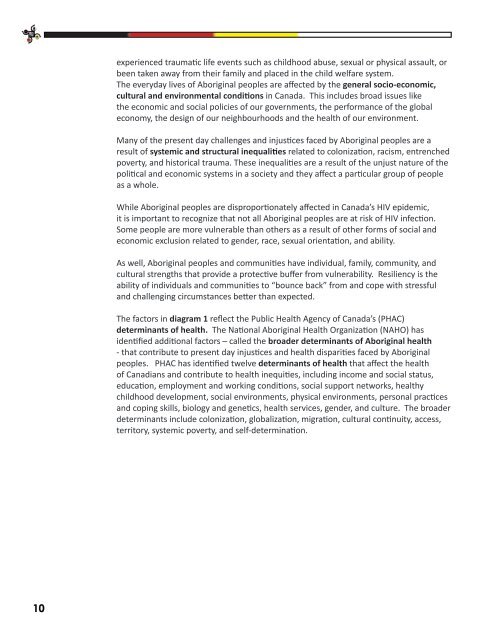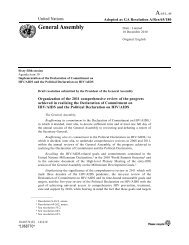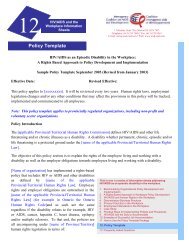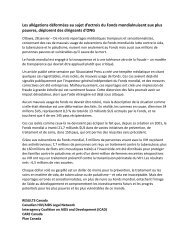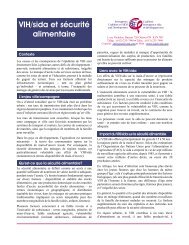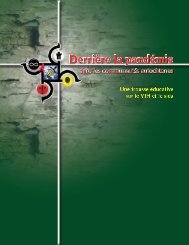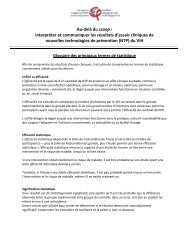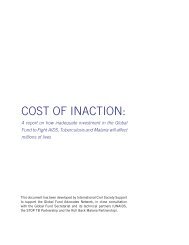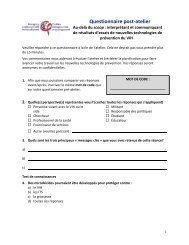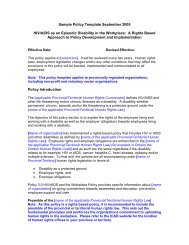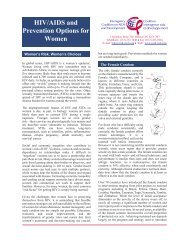experienced traumatic life events such as childhood abuse, sexual or physical assault, orbeen taken away from <strong>the</strong>ir family and placed <strong>in</strong> <strong>the</strong> child welfare system.The everyday lives of Aborig<strong>in</strong>al peoples are affected by <strong>the</strong> general socio-economic,cultural and environmental conditions <strong>in</strong> Canada. This <strong>in</strong>cludes broad issues like<strong>the</strong> economic and social policies of our governments, <strong>the</strong> performance of <strong>the</strong> globaleconomy, <strong>the</strong> design of our neighbourhoods and <strong>the</strong> health of our environment.Many of <strong>the</strong> present day challenges and <strong>in</strong>justices faced by Aborig<strong>in</strong>al peoples are aresult of systemic and structural <strong>in</strong>equalities related to colonization, racism, entrenchedpoverty, and historical trauma. These <strong>in</strong>equalities are a result of <strong>the</strong> unjust nature of <strong>the</strong>political and economic systems <strong>in</strong> a society and <strong>the</strong>y affect a particular group of peopleas a whole.While Aborig<strong>in</strong>al peoples are disproportionately affected <strong>in</strong> Canada’s HIV epidemic,it is important to recognize that not all Aborig<strong>in</strong>al peoples are at risk of HIV <strong>in</strong>fection.Some people are more vulnerable than o<strong>the</strong>rs as a result of o<strong>the</strong>r forms of social andeconomic exclusion related to gender, race, sexual orientation, and ability.As well, Aborig<strong>in</strong>al peoples and communities have <strong>in</strong>dividual, family, community, andcultural strengths that provide a protective buffer from vulnerability. Resiliency is <strong>the</strong>ability of <strong>in</strong>dividuals and communities to “bounce back” from and cope with stressfuland challeng<strong>in</strong>g circumstances better than expected.The factors <strong>in</strong> diagram 1 reflect <strong>the</strong> Public Health Agency of Canada’s (PHAC)determ<strong>in</strong>ants of health. The National Aborig<strong>in</strong>al Health Organization (NAHO) hasidentified additional factors – called <strong>the</strong> broader determ<strong>in</strong>ants of Aborig<strong>in</strong>al health- that contribute to present day <strong>in</strong>justices and health disparities faced by Aborig<strong>in</strong>alpeoples. PHAC has identified twelve determ<strong>in</strong>ants of health that affect <strong>the</strong> healthof Canadians and contribute to health <strong>in</strong>equities, <strong>in</strong>clud<strong>in</strong>g <strong>in</strong>come and social status,education, employment and work<strong>in</strong>g conditions, social support networks, healthychildhood development, social environments, physical environments, personal practicesand cop<strong>in</strong>g skills, biology and genetics, health services, gender, and culture. The broaderdeterm<strong>in</strong>ants <strong>in</strong>clude colonization, globalization, migration, cultural cont<strong>in</strong>uity, access,territory, systemic poverty, and self-determ<strong>in</strong>ation.10
Overview of <strong>the</strong> Educational ResourceEducational Approach<strong>Beh<strong>in</strong>d</strong> <strong>the</strong> <strong>Pandemic</strong> uses participant-centred learn<strong>in</strong>g approaches that are based on <strong>the</strong>idea/belief that people learn better through mak<strong>in</strong>g mean<strong>in</strong>g of experience ra<strong>the</strong>r thanpassively listen<strong>in</strong>g to lectures.The educational resource provides <strong>in</strong>structions for sett<strong>in</strong>g up experiences that are usedto stimulate discussion among participants and encourage <strong>the</strong>m to make connectionsbetween <strong>the</strong> experience and <strong>the</strong> real world. The depth and complexity of discussionsand what each participant learns is related to who <strong>the</strong>y are (e.g., age, gender, life experiences)and who else is <strong>in</strong> <strong>the</strong> group.Intended Learn<strong>in</strong>g Outcomes<strong>Beh<strong>in</strong>d</strong> <strong>the</strong> <strong>Pandemic</strong> provides an opportunity for participants to:99Learn how to use a population health lens to understand and respond to HIV epidemics.99Foster dialogue and understand<strong>in</strong>g around HIV vulnerability and impact amongAborig<strong>in</strong>al peoples.99Increase empathy for Aborig<strong>in</strong>al peoples from groups that are particularly affectedby HIV, <strong>in</strong>clud<strong>in</strong>g sex workers, drug users, and men who have sex with men.99Encourage actions that <strong>in</strong>crease access to HIV prevention, treatment, care and support<strong>in</strong> Aborig<strong>in</strong>al communities.Facilitator’s Note:The facilitator hasa very importantrole <strong>in</strong> participant-centredprocesses byguid<strong>in</strong>g <strong>the</strong> groupthrough <strong>the</strong> activitiesand creat<strong>in</strong>g a structure<strong>in</strong> which <strong>the</strong> group candiscuss and learn. It islikely that you will alsolearn from <strong>the</strong> participants.The ActivityThe ma<strong>in</strong> activity <strong>in</strong> <strong>Beh<strong>in</strong>d</strong> <strong>the</strong> <strong>Pandemic</strong> workshop is based on <strong>the</strong> popular children’sgame Snakes and Ladders, which was created <strong>in</strong> ancient India. The <strong>Beh<strong>in</strong>d</strong> <strong>the</strong> <strong>Pandemic</strong>adaptation of this game us<strong>in</strong>g canoes and rapids looks at how factors <strong>in</strong> people’s social,physical, and economic environments can put <strong>the</strong>m at <strong>in</strong>creased risk of contract<strong>in</strong>g HIVand speed up disease progression or protect <strong>the</strong>m from HIV and support positive liv<strong>in</strong>g.The rapids represent structural and systemic factors that contribute to <strong>the</strong> vulnerabilityof Aborig<strong>in</strong>al people, such as colonialism, racism, poverty, access to hous<strong>in</strong>g, employment,and food. They also <strong>in</strong>clude life experiences - such as child abuse, addictions, andfamily violence - that affect one’s ability to reduce HIV risk and live positively. The canoesrepresent factors with<strong>in</strong> people, families, communities, and societies that help <strong>in</strong>dividualsto effectively navigate vulnerability and thrive even <strong>in</strong> difficult circumstances.Navigat<strong>in</strong>g <strong>the</strong> Educational ResourceThe educational resource <strong>in</strong>cludes:• Step-by-step <strong>in</strong>structions for facilitat<strong>in</strong>g <strong>the</strong> activity and discussions with<strong>in</strong> <strong>the</strong>workshop.• An accompany<strong>in</strong>g Power Po<strong>in</strong>t Presentation.• Paper-based materials to implement <strong>the</strong> activity. Facilitator will also need to providesome additional materials, such as dice, player markers, flipchart paper andmarkers.• Participant handouts to support learn<strong>in</strong>g and dialogue.• Facilitator background notes.11
- Page 6 and 7: Facilitator’s Materials..........
- Page 8 and 9: What is this Educational Resource f
- Page 12 and 13: Getting Ready to Facilitate this Ed
- Page 14 and 15: Table 1: Potential Audiences and Ad
- Page 16 and 17: Overview of Workshop AgendaOutlined
- Page 18 and 19: WorkshopEtiquette(Social Norms)5 Mi
- Page 20 and 21: Fred’s Story:LandscapeThinking(co
- Page 22 and 23: Facilitator’s Note:It is possible
- Page 24 and 25: Facilitator’s Note:Resiliency mea
- Page 27 and 28: Participant MaterialsActivity Mater
- Page 29 and 30: Individual LevelIndividual LevelInd
- Page 31 and 32: Family LevelIndividual LevelFamily
- Page 33 and 34: Family LevelFamily LevelFamily Leve
- Page 35 and 36: Community LevelCommunity LevelCommu
- Page 37 and 38: Community LevelCommunity LevelCommu
- Page 39 and 40: Systemic LevelSystemic LevelSystemi
- Page 41 and 42: Systemic LevelSystemic LevelSystemi
- Page 43 and 44: Systemic LevelSystemic LevelSystemi
- Page 45 and 46: Systemic LevelArmand’s StoryArman
- Page 47 and 48: Activity Materials: Resiliency Card
- Page 49 and 50: Community Healing and Self-Determin
- Page 51 and 52: Cultural ContinuityYou live in a co
- Page 53 and 54: Building Community CapacityEveryone
- Page 55 and 56: GIPA and ResearchA few years ago, t
- Page 57: Handout #1: HIV Basics 11CATIE. 201
- Page 62 and 63:
10/21/2010Activity Purpose• Incre
- Page 65 and 66:
9/27/2010Activity InstructionsActiv
- Page 67 and 68:
9/27/2010Questions for Vulnerabilit
- Page 69 and 70:
9/27/2010Fred’s StoryHas no fridg
- Page 71 and 72:
9/27/2010Understanding Health Inequ
- Page 74 and 75:
9/27/2010Root Causes: BroaderDeterm
- Page 76 and 77:
9/27/2010Broader Determinants ofAbo
- Page 80 and 81:
Facilitator’s Note:These backgrou
- Page 82 and 83:
Gender and Gender Inequalities• G
- Page 84 and 85:
approach must be undertaken with in
- Page 86 and 87:
through collaboration and shared re
- Page 88 and 89:
Diagram 1: Factors that affect HIVv
- Page 90 and 91:
Card Key Issues Affecting Vulnerabi
- Page 92 and 93:
Card Key Issues Affecting Vulnerabi
- Page 94 and 95:
Card Key Issues Affecting Vulnerabi
- Page 96 and 97:
Individual LevelIssue Exploration T
- Page 99 and 100:
Card Key Protective Factors Suggest
- Page 101 and 102:
Card Key Protective Factors Suggest
- Page 103 and 104:
Glossary
- Page 105 and 106:
Gender norms refer to the expectati
- Page 107 and 108:
About the AuthorsLia De Pauw, MHSc,
- Page 109 and 110:
Bouey, Paul D., and Betty E. S. Dur
- Page 111 and 112:
Public Health Agency Health of Cana
- Page 113 and 114:
Mill, Judy E., Randy C. Jackson, Ca
- Page 115 and 116:
Scanlon, K., Travers, R., Humberto,


